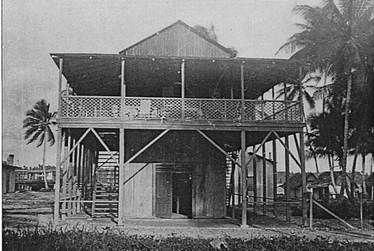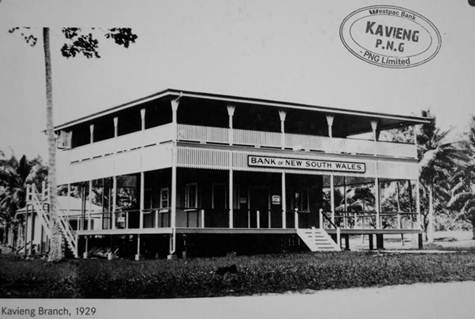First bank in Kavieng: Jim Ridges
© Jim Ridges in Kavieng
The Westpac Bank of PNG, renamed from the original Bank of New South Wales, is rightly celebrating 100 years of trading in Papua New Guinea, having opened their first branch at Port Moresby in 1910, and is, as they are frequently telling us, “The first bank in PNG”.
But not the first bank in Kavieng, as many people in New Ireland believe when told that the first time a branch of the Bank of New South Wales opened in Kavieng was in 1927. The bank in Kavieng operated then from a lovely, wide verandas all round and therefore cool and shady, two-storey establishment located where the Kavieng Club was built after the war and is now.
The bank building was used as HQ by the occupying Japanese forces, and there are still bunkers there to prove it, until bombed and totally wrecked in 1944. For whatever reason the bank did not return to Kavieng immediately after the war.
There were no banks as such operating in German New Guinea prior to the Australian military occupation in the First World War, at Rabaul in September 1914, and 17 October for Kavieng. The larger German trading houses had fulfilled the role of banks at that time, offering credit and letters of credit as requested, but with the influx of about fifteen hundred Australian soldiers into German New Guinea, and the likelihood of them remaining until after the end of the war, whenever that would be, the Australian government could not operate using enemy owned and controlled businesses.
 In 1915 the Commonwealth Bank of Australia opened its first branch in Rabaul, and in 1916 at Kavieng, mainly to serve the needs of the military administration and the Australian soldiers and, as the German businesses and plantations were forbidden to trade with the enemy Germany, no doubt to facilitate their obligatory business dealings in Australia.
In 1915 the Commonwealth Bank of Australia opened its first branch in Rabaul, and in 1916 at Kavieng, mainly to serve the needs of the military administration and the Australian soldiers and, as the German businesses and plantations were forbidden to trade with the enemy Germany, no doubt to facilitate their obligatory business dealings in Australia.
The Commonweath Bank of Australia, Kawieng, operated from a two storey building roughly where a road led down to the present Kavieng main wharf area, near where Shell is today.
It must be remembered that it was only on 16 May 1916 that the “British Military Administrator” entered into an agreement with Frederick Arthur Smith, the planter and sawmiller on Tsoi Launung island,1 “for the building of a wharf on a certain piece of land at Bagail being Block Number 26/5”. He also leased and later operated the wharf when complete in 1917, collecting charges gazetted on 15 April 1917.
On 14 June 1918 (gazetted 24 September 1918) he was relieved of his duties and lease “in the events that happened the Administrator did re-possess and re-enter upon the said land and wharf”. Thereafter it was ‘managed and carried on… as a government wharf.
In 1920, after the war had ended in 1918, and the Versailles peace agreement in 1919 had allowed Australia to take German property to compensate it for war expenses, the Australian parliament legislated to expropriate German property, both business and personal, and the Custodian of Expropriated Properties was established. From 1920 when all the properties were taken over, until 1927 when the tenders offered in 1925/6 were approved, the COEP dominated business and life in the Territory of New Guinea.
 However, in accordance with the mandate given by the League of Nations to Australia, the military administration was replaced by a civil administration on 9 May 1921, even though most of the military personnel just changed hats and continued in their civilian clothes. This meant that the Australian Government, the owners of the Commonwealth Bank of Australia, no longer had a direct interest in payment and services to its soldiers, so the decision was made, and the Kawieng branch of the Commonwealth Bank of Australia ceased operations on 31 December 1923, much to the annoyance of the Expropriation Board, as it meant that they had to maintain a much larger cash advance in their Kavieng office, managed by Frank Saunders at the time, in order to meet the need for cash of just about all the plantations and business in the province, that the Board now managed.
However, in accordance with the mandate given by the League of Nations to Australia, the military administration was replaced by a civil administration on 9 May 1921, even though most of the military personnel just changed hats and continued in their civilian clothes. This meant that the Australian Government, the owners of the Commonwealth Bank of Australia, no longer had a direct interest in payment and services to its soldiers, so the decision was made, and the Kawieng branch of the Commonwealth Bank of Australia ceased operations on 31 December 1923, much to the annoyance of the Expropriation Board, as it meant that they had to maintain a much larger cash advance in their Kavieng office, managed by Frank Saunders at the time, in order to meet the need for cash of just about all the plantations and business in the province, that the Board now managed.
No doubt this pressure from Kavieng helped the Bank of New South Wales to make the decision to open its branch in Kavieng in 1927, after over three years with no bank services, and especially aimed at obtaining the business of the many new owners of plantations and business following their successful tenders of the German properties in 1925/6 that were finally approved in 1927.
First bank in PNG ‘Yes’, but in Kavieng ‘No’. Thank you, Westpac Bank PNG Ltd.
1Frederick Arthur Smith died 18 January 1924, and is buried at Pakail Pioneers cemetery, Kavieng.


